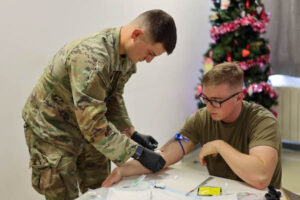
Story by Staff Sgt. Larry Barnhill
22nd Mobile Public Affairs Detachment
Mihail Kogalniceanu Air Base, Romania — One of the most important steps is controlling bleeding when caring for a casualty. With this in mind, the Joint Troop Medical Clinic (JTMC) personnel led battlefield blood transfusion training for all medics assigned to rotational and tenant units here on March 7, 2024.
Medics in attendance received hands-on training for conducting autologous blood transfusions. An autologous blood transfusion uses the patient’s blood for medical emergencies. The patient’s blood is drawn, stored, and later returned to the patient at the end of the process.
This training also emphasized the importance of ‘walking blood banks’ and how they can benefit a unit should the need arise.
Sgt. Andrew Montgomery, a combat medic and JTMC noncommissioned officer in charge, led the course instruction and highlighted the important parts of the training session and why medics need it.
“Today we started off with a 30-minute didactic section of the lethal diamond highlighting what drugs we push in our clinical practice guidelines and how to low titer your patients so you can bring them out to a deployed environment and make sure they have enough of their own blood for a 90-day supply,” said Montgomery. Low titer refers to the process of efficiently removing infectious pathogens by the immune system.
“We also did a practical hands-on portion by taking blood out of a patient and putting the blood back into the same patient,” he added.
One of the rotational Soldiers in attendance, Pfc. Blake Jenkins, a laboratory technician assigned to the 626th Brigade Support Battalion, 3rd Brigade Combat Team, 101st Airborne Division, stressed the importance of this type of training.
“This is really important knowledge because having the proper training beforehand will prevent people from panicking while giving proper aid,” said Jenkins. “This is a very important thing to learn to really support the American troops and NATO as a whole so that if we have a patient that is in a life-or-death scenario, not just medics need to know this, but every personnel should know this to help save a person’s life.”
Montgomery reiterated the intended outcome of the training and what the medical goal brings to save a life on the battlefield.
“We want to initiate the walking blood bank as soon as the person is dictated to be in hemorrhagic shock; if we can get blood on board immediately, that’s the best-case scenario for that patient,” said Montgomery. “This is applicable in every scenario for a medic, and each participant can take this training back to their platoons and make the overall force more effective in combat.”
The presence of rotational units in the Baltic and Black Sea Regions demonstrates the V Corps’ unwavering commitment to NATO for collective defense and regional security. Training enables the V Corps to fight and win across the full spectrum of operations, from contingency response to large-scale ground combat operations.